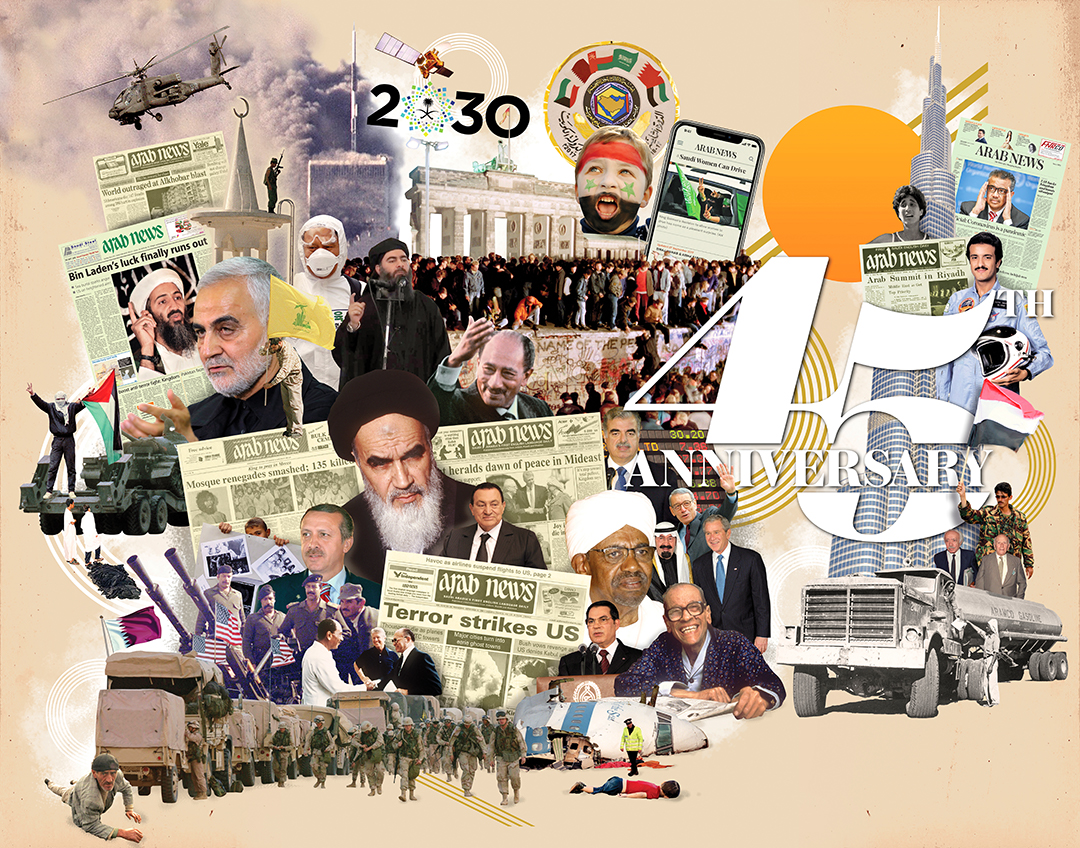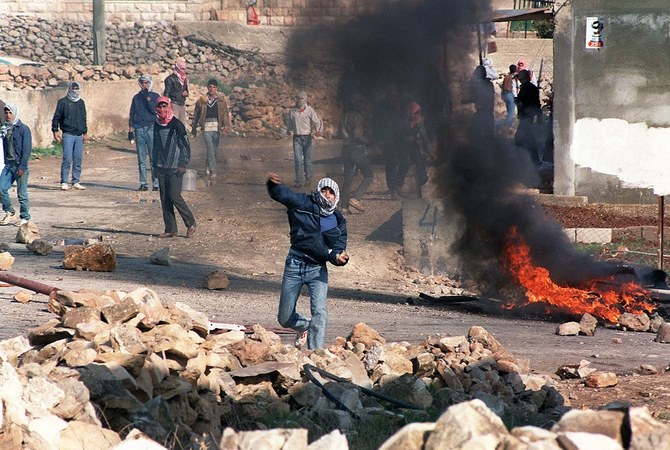Nonviolent resistance lay at the heart of the movement for self-determination.
Summary
On Dec. 8, 1987, a tank transporter being driven by an Israeli soldier crashed into a car in the Jabalya refugee camp in the Gaza Strip, killing four Palestinians and triggering what became known as the first intifada.
The series of protests that began on Dec. 9, many of them based on nonviolent resistance, exploded after years of frustration and anger provoked by Israeli oppression in the occupied territories. The uprising cost the lives of 2,000 Palestinians and more than 200 Israelis.
The intifada led to the 1991 Madrid peace conference and the 1993 Oslo Accord, which saw the creation of the Palestinian Authority and recognition by the Palestine Liberation Organization of Israel’s right to exist.
Peace, however, proved elusive. In September 2000, a second intifada began following the provocative visit of Israeli opposition leader and future Prime Minister Ariel Sharon to Al-Aqsa Mosque, the third-holiest site in Islam.
AMMAN: The intifada (Arabic for “shaking off”) was introduced to the English lexicon by many of us Palestinian journalists working with the foreign media in the Middle East. What was being shaken off was the status quo of living under occupation.
Before the intifada began, I was way too young to agree to the job offer that was made to me. With a BA in business from the US, the American-Palestinian owner of Al-Fajr, Paul Ajlouny, thought I could do a good job in bringing business sense to running the Jerusalem-based family newspaper. I did not, and I hated the job.
But while I was busy making ends meet, an English-language sister publication, Al-Fajr English, was being created by Ajlouny’s relative Hanna Siniora. At the young age of 25 and still a bachelor, I enjoyed proofreading and was mesmerized seeing Al-Fajr go to press each week. Eventually, I would write my first article and was fascinated to see my byline in print.
The big story at the time was the assassination attempt against nationalist Palestinian mayors by Jewish militants. The return of Mayor Bassam Shaka’a after months of treatment in Europe, and the huge public welcome in the city of Nablus, adorned our front page.
Shaka’a, Hebron Mayor Fahd Qawasmeh and Ramallah’s Karim Khalaf (who was badly injured when he tried to start his booby-trapped car), were supporters of the Palestine Liberation Organization (PLO).
By the time I left the business job to become a fulltime journalist, Israel had invaded Lebanon, and the PLO’s heroic 82-day steadfastness in Beirut, followed by its departure to Tunis, was our main story.
It was in this nationalist atmosphere that my cousin Mubarak had also returned from the US and started the Palestinian Center for the Study of Nonviolence. Along with my brother Jonathan, co-founder of the independent Palestinian human rights organization Al-Haq, they educated people in the occupied territories about how nonviolent resistance works.

“Demonstrators who stoned Israeli troops, hurled petrol bombs, barricaded streets and burned tires over the last week had an average age of about 15.”
From a Reuters story on Arab News’ front page, Dec. 14, 1987
While talk of nonviolence was new to many, it was well-received by some key leaders. I remember joining Mubarak and Jonathan in meetings with a student leader at Bir Zeit University named Marwan Barghouti, as well as many meetings with other Palestinian notables such as Faisal Husseini, Sari Nusseibeh and Hanan Ashrawi.
Mubarak’s message was quickly being absorbed, and he was getting calls from people from different parts of Palestine suffering from problems with settlers and the Israeli military. Nonviolent protests were taking place a couple of times per week, often with important results.
But while Mubarak’s work had not yet become mainstream, it was not long before the Israelis realized what was happening and started tracking him. They arrested him despite the fact that he had a US passport, and despite many protests that were held in Jerusalem on his behalf.
Key Dates
-
1An Israeli truck crashes into a car in Jabalya refugee camp in the Gaza Strip, killing four Palestinians.

-
2The Palestinian intifada against Israeli occupation begins, triggered by the previous day’s fatal crash.
-
3The Arab League announces that it will support the intifada financially, a pledge it renews in 1989.
-
4Israeli authorities deport Mubarak Awad, a nonviolent activist known as the Palestinian Gandhi.

-
5PLO Chairman Yasser Arafat reads the Palestinian Declaration of Independence at a meeting of the Palestinian National Council in Algiers.
-
6Madrid peace conference takes place.
-
7The PLO and Israel sign a Declaration of Principles — the Oslo Accord — at the White House.

-
8Multilateral talks resume but stall soon after.
-
9Israeli opposition leader Ariel Sharon visits Al-Aqsa Mosque, triggering the second intifada.

The man who became known as the Palestinian Gandhi lost his case in Israel’s High Court and was deported, despite being born in Jerusalem, on orders from right-wing Prime Minister Yitzhak Shamir. But the literature he distributed, and his ideas about nonviolence and boycotts, lingered.
Palestinian anger erupted on Dec. 9, 1987, in the Jabaliya refugee camp in the Gaza Strip, the day after an Israeli military truck collided with a civilian car, killing four Palestinians. While many saw in the clashes with Israelis a public expression of this anger, it was the fact that settlers were continuing to build without any deterrence that led Palestinian youths to fight them with the only freely available weapon to them: Stones, which are abundant in Palestinian towns and villages.
While the intifada’s images were those of young Palestinians, often dressed in black and white keffiyehs, pelting settlers and soldiers with stones, it was the nonviolent actions throughout Palestine that fascinated me.
While the intifada’s images were those of young Palestinians, often dressed in black and white keffiyehs, pelting settlers and soldiers with stones, it was the nonviolent actions throughout Palestine that fascinated me.
Daoud Kuttab
Perhaps the most visible of these actions was the decision by the people of Beit Sahour to adopt the slogan of American revolutionaries: No taxation without representation. Palestinians living in the town decided to stop paying taxes as long as they had no political power. This drove the Israeli military crazy, and it laid siege to Beit Sahour.
An iconic sign of nonviolent resistance was the decision not to follow Israel when it changed its clocks in April due to summertime. I remember covering stories about Israeli soldiers outside Damascus Gate in Jerusalem stopping young Palestinians and looking at their watches. If they had not changed the times on their watches, the soldiers would use batons to smash them while on the youths’ wrists.

A page from the Arab News archvie showing the news on Dec. 14, 1987.
The intifada finally ended when US Secretary of State James Baker asked the Palestinians to attend the Madrid peace conference in 1991. The Israelis were represented at the conference by Shamir, who had deported Mubarak. The Israeli delegation’s spokesman was current Prime Minister Benjamin Netanyahu. The Palestinian delegation’s spokeswoman was Ashrawi.
Nothing happened as a result of that conference, but a secret agreement worked out in Oslo led to an initial breakthrough that led to the creation of the Palestinian Authority and the return of the PLO to the occupied Palestinian territories.
But that achievement, and the hope of peace that many had suffered for, was wiped out when an extremist Jewish settler assassinated Israel’s then-Prime Minister Yitzhak Rabin, paving the way for Netanyahu’s first term as premier. Things have gone backward for Palestinian rights and aspirations ever since.
- Daoud Kuttab is Arab News’ Middle East reporter covering Palestine and Jordan. In the 1980s, he was the editor of the only English-language Palestinian newspaper, Al-Fajr, and a freelance correspondent / fixer with the foreign media. He has received numerous awards, including Press Freedom Hero from the International Press Institute and from the Committee to Protect Journalists.














